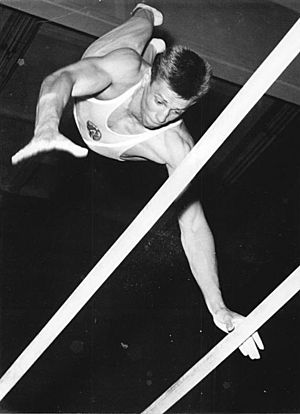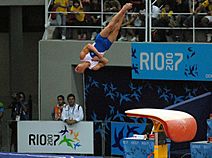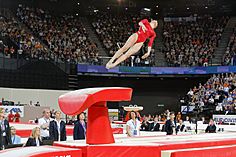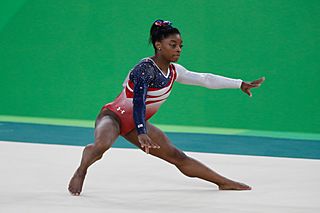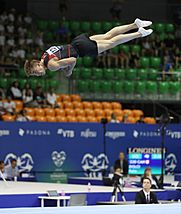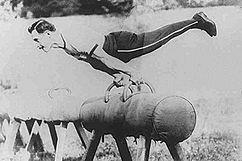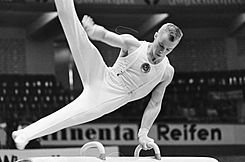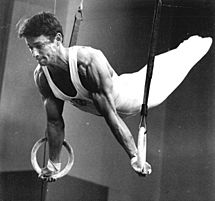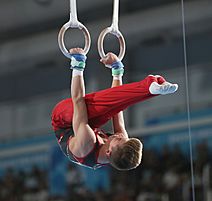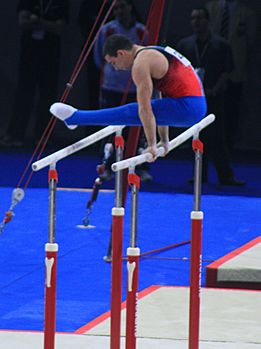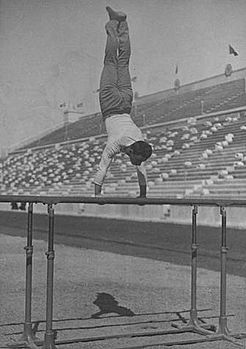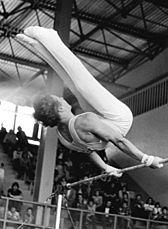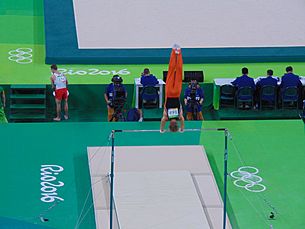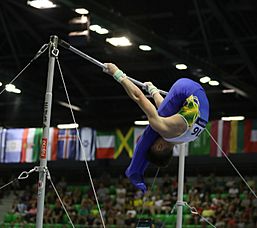Artistic gymnastics facts for kids
| Highest governing body | Fédération Internationale de Gymnastique |
|---|---|
| Registered players | 1881 |
| Characteristics | |
| Mixed-sex | Yes |
| Type | Indoor |
| Presence | |
| Olympic | Since the first Summer Olympics in 1896 |
Artistic gymnastics is a type of gymnastics where athletes perform short routines on different pieces of equipment. The sport is managed by the Fédération Internationale de Gymnastique (FIG). They create the rules for scoring and oversee all major international competitions. In each country, national groups like British Gymnastics and USA Gymnastics manage the sport. Artistic gymnastics is a popular sport to watch, especially at big events like the Summer Olympic Games.
Contents
History of Gymnastics
Gymnastics was first mentioned in ancient writings by famous people like Homer, Aristotle, and Plato. Back then, it included many activities that are now separate sports, such as swimming, racing, wrestling, boxing, and horse riding. It was also used for military training.
Modern artistic gymnastics began in the early 1800s in places like Bohemia and Germany. The name "artistic gymnastics" was created to show that these performances were different from military exercises. A German teacher named Friedrich Ludwig Jahn, often called the "father of gymnastics," invented several pieces of equipment, including the horizontal bar and parallel bars, which are still used today. Some of the first gymnastics clubs were called Turnvereins and Sokols.
The FIG was started in 1881. It was first called the European Gymnastics Federation and only had three countries. In 1921, more countries from outside Europe joined, and it became the Fédération Internationale de Gymnastique, as it is known today.
Gymnastics was part of the very first Summer Olympics in 1896. However, women were not allowed to compete in the Olympics until 1928. The World Artistic Gymnastics Championships, which started in 1903, were only for men until 1934. Since then, two main types of artistic gymnastics have grown: women's artistic gymnastics (WAG) and men's artistic gymnastics (MAG). Unlike many other sports, WAG and MAG have very different techniques and use different equipment in major competitions.
Women's Artistic Gymnastics
Women's gymnastics became a team event at the Olympics in 1928 and at the World Championships in 1950. Individual women started being recognized in the all-around competition at the 1934 World Championships. The women's program we see today—which includes the all-around and individual events on vault, uneven bars, balance beam, and floor exercise—was introduced at the 1950 World Championships and the 1952 Summer Olympics.
Early champions in women's gymnastics were usually in their 20s and had often studied ballet for many years. For example, Larisa Latynina, a great Soviet gymnast, won her first Olympic all-around medal at 22. Věra Čáslavská of Czechoslovakia, another two-time Olympic all-around champion, was 22 when she won her first Olympic gold.
In the 1970s, the average age of Olympic gymnasts started to get younger. As the sport became more difficult, smaller and lighter girls often did better with the new acrobatic moves. In 1980, the FIG decided to raise the minimum age for top international competitions from 14 to 15. This change took effect two years later. However, by the 1992 Summer Olympics, most elite gymnasts were very young teenagers. People became concerned about the gymnasts' well-being.
In 1997, the FIG raised the minimum age for international elite competitions to 16. This, along with changes in the scoring rules and changing opinions in the sport, led to older gymnasts returning. While the average elite female gymnast is still a teenager, it's now common to see gymnasts competing well into their 20s. For example, at the 2004 Olympics, the American and Russian teams were led by women in their mid-20s. At the 2008 Olympics, Oksana Chusovitina won a silver medal on vault at 33 years old.
Gymnastics Equipment
Both male and female gymnasts are judged on how well they perform, how difficult their routine is, and their overall presentation. In many competitions, especially high-level ones approved by the FIG, gymnasts compete in a specific order called "Olympic order." This order has changed over time but has been the same for several decades.
For male gymnasts, the Olympic order is:
- Floor exercise
- Pommel horse
- Still rings
- Vault
- Parallel bars
- Horizontal bar
For female gymnasts, the Olympic order is:
Equipment for Both Men and Women
Vault
The vault is both an event and the main piece of equipment used. It's used in both men's and women's competitions, with very few differences. A gymnast runs down a runway (up to 25 meters long) and then jumps onto a springboard. Using the spring's energy, the gymnast pushes off the vaulting platform with their hands. They then rotate their body to land standing on the other side of the vault. In advanced gymnastics, gymnasts can add many twists and somersaults before landing. Good vaults depend on the speed of the run, the power from the gymnast's legs and shoulders, and how fast they can spin in the air.
In 2004, the old vaulting horse was replaced with a new, safer apparatus called a "tongue" or "table." It is more stable, wider, and longer (about 1 meter long and wide), giving gymnasts a bigger surface to push off. This new equipment has helped gymnasts try more difficult vaults.
Famous Vault Champions
For men, Marian Drăgulescu (Romania) and Ri Se-gwang (North Korea) have won the most Olympic or World titles on vault, with four each.
For women, Věra Čáslavská (Czechoslovakia) has won the most titles, with four.
Floor Exercise
The floor event takes place on a carpeted 12 x 12 meter square. It has hard foam over plywood, supported by springs or foam blocks. This gives gymnasts a firm surface that pushes back, helping them get more height and land softer than on a regular floor.
Men perform without music for 60 to 70 seconds. They must touch each corner of the floor at least once. Their routines include tumbling passes to show flexibility, strength, balance, and power. They also perform non-acrobatic moves like circles and handstands.
Women perform a 90-second routine choreographed to instrumental music. Their routines include tumbling passes, jumps, dance moves, acrobatic skills, and turns. Top gymnasts might do up to four tumbling passes.
Famous Floor Exercise Champions
For men, Marian Drăgulescu (Romania) has won the most Olympic or World titles on floor, with four.
For women, Simone Biles (United States) has the most titles (6), followed by Larisa Latynina (Soviet Union) with four.
Equipment for Men Only
Pommel Horse
A typical pommel horse routine involves both single leg and double leg moves. Single leg skills often look like "scissors." In double leg work, the gymnast swings both legs in a circular motion. To make it harder, gymnasts add variations like turning ("moores" and "spindles") or spreading their legs wide ("flares"). Routines end with a dismount, where the gymnast swings off the horse or lands after a handstand.
Famous Pommel Horse Champions
Miroslav Cerar (Yugoslavia), Zoltán Magyar (Hungary), and Max Whitlock (Great Britain) have won the most Olympic or World titles on pommel horse, with five each.
Still Rings
The still rings hang from wire cable 5.8 meters off the floor. They are adjusted so the gymnast can hang and swing freely. Gymnasts must show balance, strength, power, and dynamic moves while keeping the rings from swinging. At least one static strength move is required, but some gymnasts do two or three.
Famous Still Rings Champions
Jury Chechi (Italy) has won the most Olympic or World titles on still rings (6), followed by Chen Yibing (China) with five.
Parallel Bars
The parallel bars are two bars placed slightly wider than shoulder-width apart, usually 1.75 meters high. Gymnasts perform a series of swings, balancing moves, and releases that need great strength and coordination.
Famous Parallel Bars Champions
Vladimir Artemov (Soviet Union) has won the most Olympic or World titles on parallel bars (5), and Li Xiaopeng (China) has four.
Horizontal Bar
The horizontal bar (also called the high bar) is a 2.4 cm thick steel bar raised 2.5 meters above the ground. Gymnasts perform "giants" (360-degree spins around the bar), release moves, twists, and changes of direction. By using the speed from giants, they can get enough height for amazing dismounts, like a triple-back somersault. Gymnasts often wear leather grips to help them hold onto the bar.
Famous Horizontal Bar Champions
Epke Zonderland (Netherlands) has won the most Olympic and World Championship titles on the horizontal bar, with four.
Equipment for Women Only
Uneven Bars
The uneven bars (also called asymmetric bars) were created from the men's parallel bars before World War I. They were first shown internationally at the 1928 Summer Olympics in Amsterdam. They have two horizontal bars set at different heights. Gymnasts perform swings, pirouettes (spins), moves between the bars, and releases.
Higher-level gymnasts usually wear leather grips to hold the bars strongly and protect their hands from painful blisters. Gymnasts sometimes wet their grips and use chalk to prevent slipping. Chalk can also be used on hands and the bar if grips are not worn.
Famous Uneven Bars Champions
Svetlana Khorkina (Russia) has won the most Olympic or World titles on uneven bars (7). Aliya Mustafina is a two-time Olympic uneven bars champion.
Balance Beam
The balance beam existed as early as the 1880s as a "low beam" close to the floor. By the 1920s, it was raised much higher.
Gymnasts perform routines that are 70 to 90 seconds long. These routines include leaps, acrobatic skills, turns, and dance moves on a padded spring beam. The rules state that the beam must be 125 cm high, 500 cm long, and 10 cm wide. This event requires excellent balance, flexibility, and strength.
Famous Balance Beam Champions
It's very hard to win many Olympic and World Championship titles on the balance beam. Only three gymnasts have won three titles: Simone Biles (United States), Nadia Comăneci (Romania), and Daniela Silivaș (Romania).
How Competitions Work
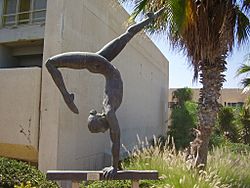
In the Olympics and World Championships, competitions are split into several parts over different days: qualifications, team finals, all-around finals, and event finals.
During the qualification round, gymnasts compete with their national team on all four (women) or six (men) events. The scores from this round don't win medals. Instead, they decide which teams go to the team finals and which individual gymnasts go to the all-around and event finals. For the 2020 Olympics, teams had four gymnasts, with up to two extra gymnasts from each country competing as individuals. In team qualifications, all four gymnasts compete on each event, but only the top three scores count.
In the team finals, gymnasts compete with their national team on all events. The scores from this session decide the medal winners for the team competition. The current rule is that out of four gymnasts on a team, three compete on each event, and all three scores count.
In the all-around finals, gymnasts compete individually on all four or six events. Their total scores decide the all-around medals. Only two gymnasts from each country can move on to the all-around finals from the qualification round.
In the event finals (or apparatus finals), the top eight gymnasts on each event (based on qualification scores) compete for medals. Only two gymnasts from each country can go to each event final.
Other competitions might use different rules. For example, the 2007 Pan American Games had only one day for team competition. Also, some events, like the World Cup series, don't have a team event at all.
New Life Rule
Since 1989, competitions have used the "new life" rule. This means scores from one part of the competition don't carry over to the next. For example, a gymnast's score in team finals doesn't affect their scores in the all-around finals or event finals.
Before this rule, scores from the team competition would count towards the all-around and event finals. This meant that a gymnast's performance early in the competition could affect their final medal chances.
Compulsory Routines
Until 1997, the team competition had two parts. In the first part, every gymnast performed compulsory routines, which were standard routines created by the FIG. On the second day, they performed optional routines, which were unique routines created by the gymnast and their coach. Team medals were based on scores from both days.
Compulsory routines were generally less difficult than optional routines, but they focused heavily on perfect technique and form. Judges would take points off for even small mistakes from the required choreography. Because of this, many gymnasts and coaches found compulsories harder than optionals.
Compulsory routines were removed at the end of 1996. This was a big debate. Many countries, like the United States, Russia, and China, felt that compulsory exercises helped gymnasts keep a high standard of technique. Others believed they made it harder for new gymnastics programs to grow.
Some people in the gymnastics world still think compulsories should come back. Many national gymnastics groups still use them in their own programs. Often, gymnasts at lower levels only perform compulsory routines.
Competition Levels
Artistic gymnasts only compete against other gymnasts at their same level. Each athlete starts at the lowest level and moves up by learning harder skills and getting good scores in competitions.
United States
In the United States, the program is run by USA Gymnastics. Levels go from 1 to 10, followed by elite. Levels 1 and 2 are for beginners. Levels 3 to 6 are intermediate. Levels 7 to elite are advanced. Competitions start at Level 3 or sometimes Level 2. To move up, a gymnast must perform specific skills on each event. Once a gymnast competes at a certain level, they can't go back to a lower level in the same season. Levels 3–5 have compulsory routines. Level 6 is a mix, and Levels 7–10 have optional routines. Only elite gymnasts follow the FIG's exact rules; lower levels have simpler rules.
The elite program has two groups: junior (under 16) and senior (16 and older). Olympic teams are chosen from the senior elite program.
United Kingdom
The British Gymnastics system has levels from 5 (lowest) to 2. There are separate paths for elite and club-level competitions.
Canada
In Canadian gymnastics, there are several competition paths: recreational, developmental, pre-competitive, provincial, national, and high-performance. Provincial levels go from 5 (lowest) to 1. National levels include pre-novice, novice, open, and high performance. High-performance levels are novice, junior, and senior.
Germany
In Germany, there are different competition systems for recreational and high-performance gymnasts. Recreational gymnasts have compulsory exercises from 1 to 9 and optional exercises from 4 to 1, with simpler rules. For high-performance and junior athletes, there are compulsory and optional rules based on age, from 6 to 18.
Age Requirements
The FIG sets a minimum age for gymnasts in certain international competitions, but there is no maximum age. A senior gymnast is a world-class or elite gymnast who meets the FIG age rules: female gymnasts must be at least 16 (or turning 16 in that calendar year), and male gymnasts must be at least 18. A junior gymnast competes at a world-class level but is too young to be a senior.
Juniors are judged using similar rules as seniors and often perform skills that are just as difficult. However, they are not allowed to compete at the Olympics, World Championships, or World Cups. Many competitions, like the European Championships, have separate events for juniors. But some events, like the Goodwill Games and Pan American Games, allow seniors and juniors to compete together.
The age rule is often debated. Those who support age limits say they encourage older athletes to stay in the sport and protect younger gymnasts from the stress of high-level training. Those against the limits argue that junior gymnasts train similar skills and need the experience of competing in major events to improve.
Since stricter age rules were put in place in the early 1980s, there have been concerns about age rules being broken. The FIG has taken action in a few cases, such as with Kim Gwang-Suk of North Korea, Hong Su-jong of North Korea, and China's Dong Fangxiao.
While the minimum age rule applies to both women and men, it's more discussed in women's gymnastics. This is because most top male gymnasts are in their late teens or early twenties, but female gymnasts are often ready for international competition by their mid-teens. This difference is mainly because men's skills often need more strength than women's skills.
Scoring in Gymnastics
Scoring at the international level follows the Code of Points.
Since 2006, two groups of judges score each routine. The D score measures the difficulty of the skills, including how hard they are and how well they are connected. The E score measures how well the gymnast performs the routine and how artistic it is. These two scores are added together for the final score. The highest E score is 10, but there's no limit to the D score. This means scores can theoretically be very high. However, in major competitions, scores are usually in the low to mid-teens.
This system, with its open-ended difficulty score, is very different from the old system. Before 2006, the highest possible score was a "perfect 10." Each routine started with a certain value based on its difficulty. Gymnasts could increase this value by doing harder skills. Then, judges would take points off for mistakes in how the routine was performed.
Some gymnasts and coaches, including Olympic gold medalists Lilia Podkopayeva and Simone Biles, did not like the new scoring system when it was first introduced. While some parts of the code were changed in 2007, there are no plans to go back to the "perfect 10" system.
Major Competitions
Global Competitions
- Olympic Games: Artistic gymnastics is one of the most popular events at the Summer Olympics, held every four years. Countries qualify teams based on how they do at the World Championships the year before the Games. Countries that don't qualify a full team might send one or two individual gymnasts.
- World Championships: These championships are only for gymnastics and are open to teams from every FIG member country. The competition changes format each year, sometimes including full team finals, all-around, and event finals, or just all-around and event finals. Since 2019, the Junior World Championships have been held every two years.
- The Artistic Gymnastics World Cup and World Challenge Cup Series
- Goodwill Games: Artistic gymnastics was part of this competition, which no longer exists.
Regional Competitions
Multi-Sport Events
- All-Africa Games: Held every four years, for teams and gymnasts from African nations.
- Asian Games: Held every four years, for teams and gymnasts from Asian nations.
- Central American and Caribbean Games: Held every four years, for teams and gymnasts from Central America, the Caribbean, Mexico, and some South American countries.
- Commonwealth Games: Held every four years, for teams and gymnasts from Commonwealth nations.
- European Games: Held every four years, for teams and gymnasts from European nations.
- Mediterranean Games: Held every four years, for gymnasts from nations around the Mediterranean Sea.
- Pan American Games: Held every four years, for teams and gymnasts from North, South, and Central America.
- South American Games: Held every four years, for teams and gymnasts from South American nations.
Gymnastics-Only Events
- Asian Gymnastics Championships: For teams and gymnasts from Asian nations.
- European Championships: Held every year, for teams and gymnasts from European nations.
- Pacific Rim Championships (formerly Pacific Alliance Championships): Held every two years, for teams from countries around the Pacific Ocean, like the US, China, Australia, and Canada.
- Pan American Gymnastics Championships: Held most years when the Pan American Games are not, for teams and gymnasts from North, South, and Central America.
- South American Gymnastics Championships: Held most years, for teams and gymnasts from South American countries.
National Competitions
Most countries hold a major competition (National Championships) every year. This competition decides the best all-around gymnasts and event specialists in the country. Gymnasts might be chosen for their country's national team or for international meets based on their scores at Nationals.
Dominant Teams and Nations
USSR and Post-Soviet Republics
Before the Soviet Union broke up in 1991, Soviet gymnasts were very strong in both men's and women's gymnastics. This started in 1952 when women's gymnastics became a full Olympic program. The Soviet Union's success might be because their government invested a lot in sports to show its strength on the world stage.
The Soviet Union had many male stars, like Olympic all-around champions Viktor Chukarin and Vitaly Scherbo. They also had many female stars, like Olympic all-around champions Larisa Latynina and Svetlana Boginskaya. From 1952 to 1992, the Soviet women's team won almost every team title at the World Championships and Olympics.
After the Soviet Union broke up, its gymnasts competed together one last time at the 1992 Summer Olympics as the Unified Team, winning both the men's and women's team competitions.
Russia has continued this strong tradition, winning medals at almost every World and Olympic competition in both men's and women's gymnastics. Ukraine also had a strong team for over ten years, with Lilia Podkopayeva winning the all-around at the 1996 Olympics. Belarus has a strong men's team.
Romania
The Romanian team became very successful at the 1976 Summer Olympics thanks to Nadia Comăneci. She was the first gymnast to score a perfect 10 in Olympic competition. After that, using a special training system, they remained a top force in women's team and individual events for almost 40 years.
Romania was one of only two teams to ever beat the Soviets in a World or Olympic competition, winning at the 1979 and 1987 World Championships. The Romanian women also won team medals at every Olympics from 1976 to 2012, including gold medals in 1984, 2000, and 2004. They also had many individual champions like Daniela Silivaș and Simona Amânar.
The Romanian women's gymnastics program started to decline after the 2004 Summer Olympics. At the 2015 World Championships, Romania didn't even qualify for the team final. In 2016, they failed to qualify a full team for the 2016 Summer Olympics.
The Romanian men's program, though not as successful as the women's, has produced individual medalists like Marian Drăgulescu and Marius Urzică.
United States
While some American gymnasts won medals in the 1970s, the United States team was not considered a top power until the late 1980s.
At the 1984 Olympics, which the Soviet bloc did not attend, the American men won gold. The women's team won a silver medal, and Mary Lou Retton became the first American Olympic all-around champion.
In 1991, Kim Zmeskal became the first American woman to win the all-around at the World Championships. At the 1992 Olympics, the American women won their first team medal (bronze) at a fully attended Games.
The U.S. women's team has become very successful in recent years. They won the team gold at the 1996 Olympics with the Magnificent Seven, and again at the 2012 Olympics and 2016 Olympics. The United States has produced the last five women's Olympic all-around champions: Carly Patterson (2004), Nastia Liukin (2008), Gabby Douglas (2012), Simone Biles (2016), and Sunisa Lee (2021). They continue to be one of the strongest forces in the sport.
The men's team won medals at the 2004 and 2008 Olympics. Paul Hamm became the first American man to win a World all-around title in 2003, and then the all-around at the 2004 Olympics.
China
China has had strong men's and women's gymnastics programs for the past 25 years. The Chinese men won team gold at the 2000 and 2008 Olympics. They have produced individual gymnasts like Olympic all-around champions Li Xiaoshuang (1996) and Yang Wei (2008).
The Chinese women's team won gold at the 2006 World Championships and 2008 Olympics. They have produced many individual gymnasts who have won Olympic gold medals, such as Liu Xuan and Deng Linlin. While they were once known for only two events (uneven bars and balance beam), China has developed strong all-around gymnasts.
Japan
The Japanese men's team was very dominant in the 1960s and 1970s, winning every Olympic team title from 1960 to 1976. This was thanks to individual gymnasts like Olympic all-around champions Sawao Katō and Yukio Endō. Many new moves created by Japanese gymnasts during this time are still used today, like the Tsukahara vault.
More recently, Japanese men have become top contenders again, winning team gold at the 2004 Olympics. Kōhei Uchimura, a six-time World champion and two-time Olympic all-around gold medalist, is considered one of the best all-around gymnasts ever.
The women's team has been less successful, but there have been individual stars like Olympic and World medalist Keiko Tanaka-Ikeda from the 1950s and 1960s. More recently, Mai Murakami won gold on floor in 2017, becoming the first Japanese woman to win a World gold medal since Tanaka-Ikeda.
Germany
Before Germany was reunified, East Germany had a very successful gymnastics program. Their men's and women's teams often won silver or bronze medals at the World Championships and Olympics. They had strong gymnasts like Andreas Wecker and Maxi Gnauck. West Germany also had international stars like Eberhard Gienger.
Since reunification, Germany has produced many medal-winning gymnasts, including Fabian Hambüchen and Pauline Schäfer. The former Soviet/Uzbek gymnast Oksana Chusovitina also competed for Germany from 2006 to 2012, winning World and Olympic medals.
Czechoslovakia
The Czechoslovakian women's team was the main rival to the Soviet women's team for decades. They won team medals at almost every World Championships and Olympics from 1934 to 1970. Their leaders included Vlasta Děkanová, the first women's World all-around champion, and Věra Čáslavská. Čáslavská won all five European, World, and Olympic all-around titles between 1964 and 1968, a feat no other gymnast has matched. Čáslavská also led Czechoslovakia to the world team title in 1966, making them one of only two countries to beat the Soviet women's team at a major competition.
The Czechoslovakian men had the most success at the World Championships before World War II. They won more medals and team titles than any other nation during that time.
Hungary
Led by gymnasts like Ágnes Keleti, who won 10 Olympic medals, the Hungarian women's team won medals at the first four Olympics that included women's artistic gymnastics (1936–1956). After a long quiet period, World and Olympic vault champion Henrietta Ónodi brought them back into the spotlight in the late 1980s and early 1990s.
The Hungarian men were not as successful as the women. However, Zoltán Magyar was dominant on the pommel horse in the 1970s, winning eight major titles. Szilveszter Csollány, a World and Olympic champion on rings, also won many medals. More recently, Krisztián Berki has won World and Olympic titles on the pommel horse.
Other Nations
Several other nations have become strong competitors in both men's and women's artistic gymnastics. This is partly due to many talented coaches moving from the USSR and other former Eastern Bloc countries.
In the last two decades, Australia, Brazil, Great Britain, Canada, France, Italy, the Netherlands, and South Korea have produced World and Olympic medalists. They have also started winning team medals at major competitions. Individual gymnasts from Croatia, Greece, North Korea, Slovenia, and Spain have also been successful.
Health in Gymnastics
Physical Health
Gymnastics is often listed as one of the world's most dangerous sports. Artistic gymnastics has a high risk of spinal and other injuries. In very rare cases, gymnasts have had fatal injuries. Julissa Gomez, an American gymnast, died in 1991 after breaking her neck three years earlier. Several other gymnasts have become paralyzed from accidents during training or competition, including Elena Mukhina of the Soviet Union and Sang Lan of China.
Mental Health
The intense pressure of the sport can also affect athletes' mental health. During the Tokyo 2020 Olympics, gymnast Simone Biles stepped back from some competitions to focus on her mental well-being. This was to ensure she wasn't putting herself at a greater risk of physical injury. Other athletes have shown their support and called for more attention to mental health in gymnastics.
See Also
 In Spanish: Gimnasia artística para niños
In Spanish: Gimnasia artística para niños
- List of current female artistic gymnasts
- List of notable artistic gymnasts
- International Gymnastics Hall of Fame
- List of Olympic medalists in gymnastics (men)
- List of Olympic medalists in gymnastics (women)
- Artistic gymnastics terms named after people


